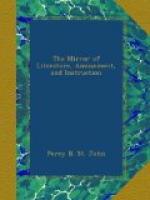“With Dr. Hoadley, who corrected the manuscript of the Analysis of Beauty for the press, Hogarth was on such friendly terms that he was admitted into one of the private theatrical exhibitions which the doctor loved, and was appointed to perform along with Garrick and his entertainer, a parody on that scene in Julius Caesar where the ghost appears to Brutus. Hogarth personated the spectre, but so unretentive—(we are told)—was his memory that though the speech consisted only of two lines he was unable to get them by heart, and his facetious associates wrote them on an illuminated lantern that he might read them when he came upon the stage. Such is the way in which anecdotes are manufactured, and conclusions of absence or imbecility drawn. The speech of the ghost written on the paper lantern formed part of the humour of the burlesque. Men, dull in comprehending the eccentricities of genius, set down what passes their own understanding to the account of the other’s stupidity.”
Here our notice of the Life of Hogarth would end, did we not feel inclined to venture a word or two respecting the omission of Hogarth’s Tailpiece, engraved in Ireland’s “Life,” and there described as his last work. With the superstitious tale attached to it almost every one is familiar; yet some notice ought surely to have been taken of the story, even had it only been to expose its falsehood and absurdity.
We find that we have proceeded but half through the volume, so that Wilson, Reynolds, and Gainsborough must remain for another number.
* * * * *
SPIRIT OF DISCOVERY.
* * * * *
Microscopic Objects.
The most delicate test objects for microscopes are the lines on the feathers of butterflies or moths’ wings, of which there are many gradations; some easily demonstrated, and others only to be seen with the most powerful reflectors, and to the best advantage by the simple and uncondensed light of the lamp. The hair of a mouse is a very good test object: it is best seen by daylight; the most difficult parts of which are longitudinal lines in the transparent part of the hair, which require high powers. The hair of the bat and seal are also fine tests. The lines on the scales of the diamond beetle, &c. are excellent opaque proof objects. The feet of flies are likewise very interesting.
* * * * *
New Lilac Dyes.
Dr. Macculloch has lately produced two fine lilac dyes from plants of domestic growth, not hitherto applied to this purpose. One is from the berry of the Portugal laurel, and the other the black currant. The simplest process with alum is all that is required for either; and as far as his trials go, the best tint is produced by the former fruit.
* * * * *
Dirty Windows.




